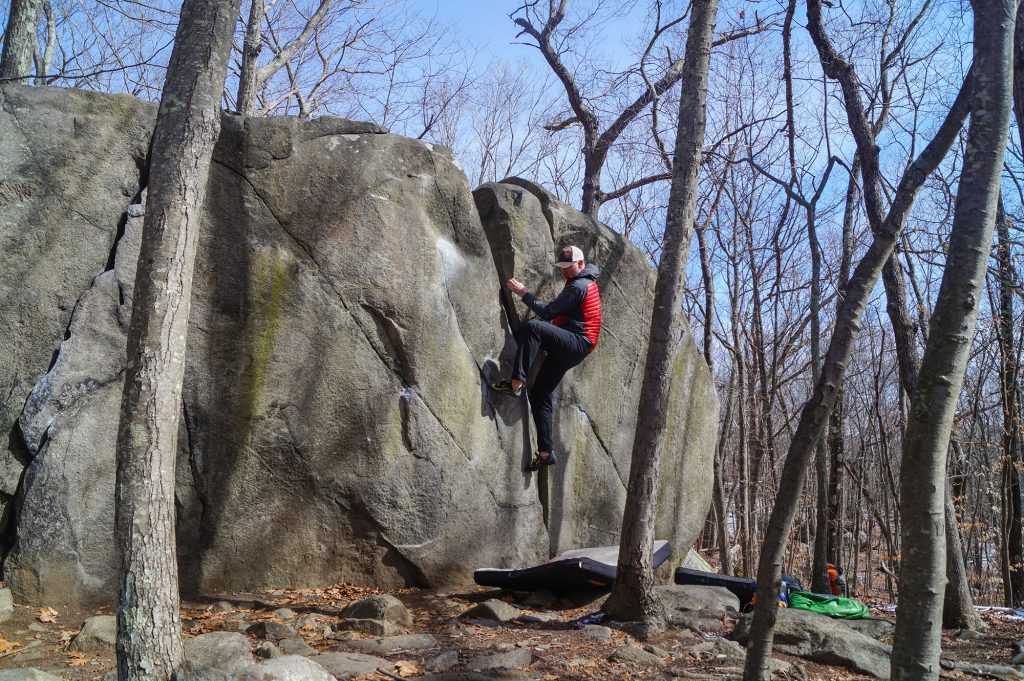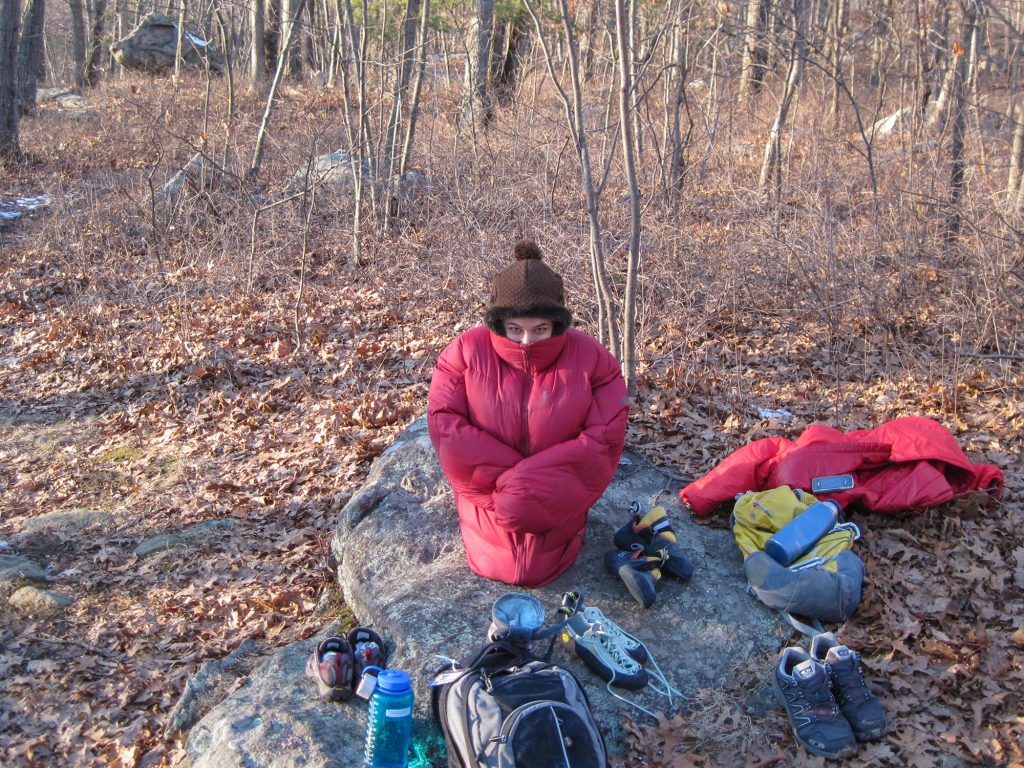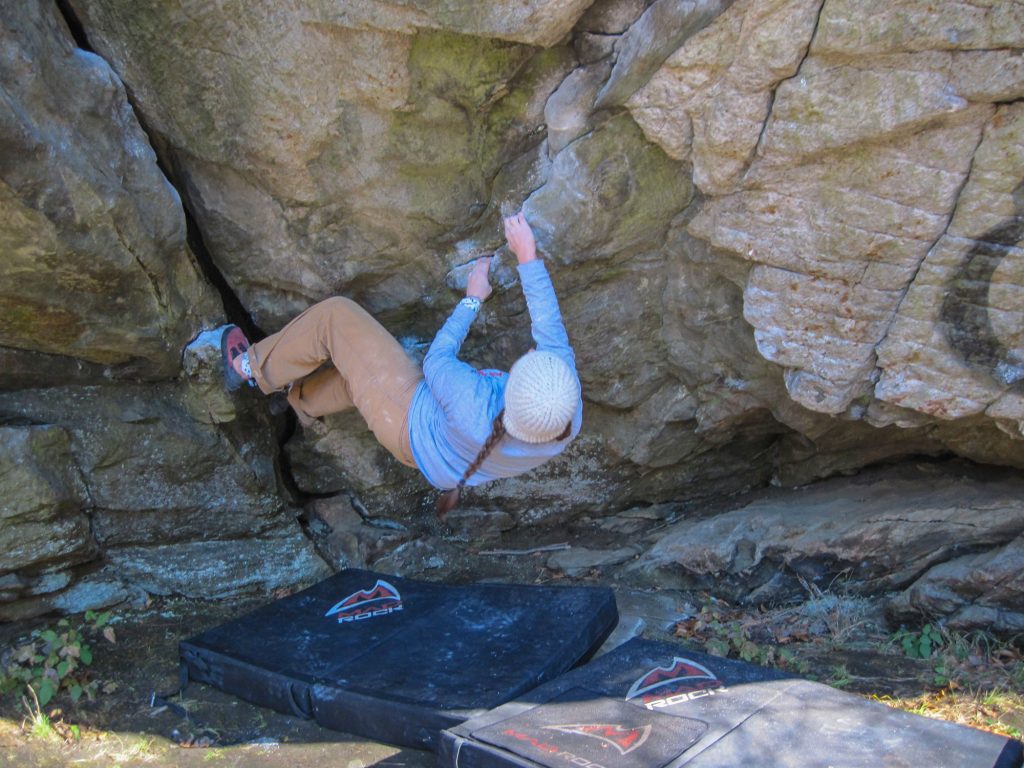During the colder winter months in New England, many boulderers put away their crash pads and renew their climbing gym memberships. However, crisp winter weather thins the large fall crowds, delivers fantastic friction, and is an ideal time to climb, particularly at places in milder, snow-free locations in the southern part of the region like Lincoln Woods or Hammond Pond. The crux of winter bouldering is often staying warm, but with some good beta, there’s no need to stop bouldering outside in the winter.
1. Layer Up
Like other outdoor activities, having the right layers can make or break a day of winter bouldering. Since bouldering tends to involve as much—if not more—resting and spotting as it does climbing, it’s a good idea to err on the side of being too warm, so pack plenty of layers.
Long underwear, either synthetic or wool, is the foundation of a good winter bouldering layering system. Take full advantage of its insulating, breathable, and quick-drying properties by layering it underneath other performance layers, such as synthetic pants, synthetic or wool mid-layers, and stretch or grid fleeces.
A puffy coat, either down or synthetic, can create a cocoon of warmth while resting or spotting—put it on whenever not climbing. A heavily insulated belay coat is ideal, and so is one with an insulated hood. However, pairing multiple light- and mid-weight puffers provides the ability to adjust to conditions. Those heading out on the coldest days might also want to consider adding a pair of puffy pants to their kit.
Ultimately, the more good layers you have, the more flexibility you have to adapt to the conditions.

2. Accessorize
It’s a myth that you lose most of your body heat through your head, but that doesn’t mean you don’t want to pack a winter hat—it should be warm and cover your ears. A neck gaiter is a nice complement to a winter hat and helps to keep your face and neck warm.
Mittens are easy to slide your hands into between burns and are warmer than gloves—they allow fingers to insulate each other and have less surface area and fewer seams for heat to escape through. Opt for an insulated pair of mittens over a woven pair for optimal warmth. And size them a little big so it’s easy to get your hands in and out.
3. Wear Insulated Footwear
Having a pair of puffy shoes to pull on is a great way to stay warm during winter bouldering and way easier than finagling with socks and shoes between burns. Down booties and synthetic puffy slip-on shoes offer warmth, convenience, and packability.
4. Pack a Blanket or Sleeping Bag
Winter bouldering is a great excuse to invest in an adventure blanket—you can either wrap yourself in it for additional warmth or use it to provide insulation from the ground while sitting on it. Don’t have an adventure blanket? A sleeping bag works equally well.
5. Bring Lots of Hand Warmers
Hand warmers are a winter boulderer’s best friend and key to keeping warm during frigid sessions. Both chemical and rechargeable warmers can be dropped into mittens, pockets, and chalk bags to keep fingers from freezing. They can also be stuffed into shoes during breaks to keep your toes toasty.

6. Generate Your Own Heat
Bouldering typically involves short bursts of intense effort followed by extended periods of recovery—which means your body is only generating heat intermittently. To avoid getting chilled, don’t sit still for too long. To keep the blood flowing when you aren’t climbing, do some jumping jacks, swing your arms, hike around a bit, or wander over to your next project.
7. Pack Warm Food and Drinks
A thermos filled with something warm like cocoa or an insulated food container with hot soup are great ways to boost body temperature and psych while winter bouldering, warming you from the inside out. It’s generally a good idea to avoid caffeine—which can cause you to feel colder—so steer clear of coffee.
Also, keep in mind that you burn more energy in the cold weather—the body expends calories to keep you warm. Make sure to give your body the fuel it needs to keep you comfortable.
8. Chase Comfy Conditions
Some times and places provide better conditions than others. If possible, plan your bouldering session so that it falls on one of the warmer and/or sunnier days of the week. Then aim for the middle of the day, which is generally the warmest. Another smart strategy is to seek out boulders that sit in the sun—south-facing problems are typically a good bet.
9. Keep Your Shoes Warm
Scrunching your feet into frozen climbing shoes is a sure way to cut a winter bouldering day short—your toes get cold, your feet get uncomfortable, and it doesn’t feel good to press onto the rock. In between burns, keep the send train going by stashing your climbing shoes in your puffy and close to your heat-generating core.

10. Keep a Positive Attitude
Perhaps the most important thing to bring winter bouldering is stoke. Just getting outside and touching some real rock is a win in the winter and beats pulling plastic at the gym, getting spanked on the Moon Board, or rewatching Free Solo for the hundredth time.
Have a winter bouldering tip you want to share? Leave it in the comments below!
Tim Peck and Doug Martland
Tim and Doug met long ago at the Eastern Mountain Sports in Canton, Massachusetts. Bonding over a love of slick Quincy Quarry granite, White Mountain sufferfests, and scheming up adventures while folding tee-shirts, today Tim and Doug collaborate to write about their favorite outdoor activities and occasionally get nostalgic about tee-shirt tables.
Related Posts
April 2, 2024
10 Tips for Mountain Biking Etiquette During Mud Season
One rough spring could ruin the…




